Pongal Feast: Sweet & Savoury Pongals with Perfect Side Dishes for the Harvest Festival
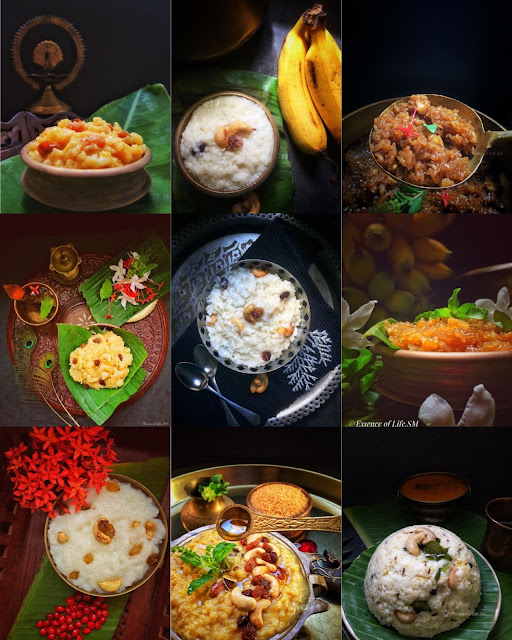 |
| A Festive Collection of Pongal Delights |
Pongalo Pongal: A Celebration of Harvest and Tradition
The arrival of January marks the beginning of the vibrant Pongal Season, a time of gratitude, joy, and traditional feasting. Pongal, both a harvest festival and a dish, beautifully encapsulates the spirit of Tamil Nadu’s agrarian culture. The festival’s name derives from the Tamil word "Pongal," meaning "to boil over," symbolising abundance and prosperity. In this post, we’re diving into the world of Pongal recipes—a mix of both sweet and savoury delights that you can recreate in your kitchen to celebrate the season.
What is Pongal? A Festival and a Dish
Pongal is a four-day-long harvest festival dedicated to the Sun God for blessing the crops and sustaining life. Each day of Pongal holds a unique significance:
- Bhogi: The first day celebrates new beginnings with a ritual cleansing of homes, discarding old belongings, and welcoming prosperity. A special bonfire is lit as part of the festivities.
- Thai/Surya Pongal: The second day, dedicated to the Sun God, is the main day of the festival. Families prepare the traditional Pongal dish and offer it to the Sun as a gesture of gratitude.
- Mattu Pongal: The third day honours cattle, recognising their vital role in agriculture. Cows and bulls are adorned with garlands, painted horns, and worshipped.
- Kaanum Pongal: The final day is a time for socialising and relaxation. Families and friends gather for picnics, and younger members seek blessings from elders.
Rice, the staple crop of South India, takes centre stage during Pongal, and the festivities are incomplete without an array of dishes prepared using freshly harvested rice. From the iconic Sarkkarai Pongal (Sweet Pongal) to the savoury Ven Pongal, the season’s menu highlights traditional recipes brimming with authentic flavours. While Sarkkarai Pongal is sweetened with jaggery and enriched with ghee-fried nuts and raisins, Ven Pongal is a simple yet flavourful savoury dish, seasoned with spices and tempered with curry leaves. Adding to the line-up, specialities like Akkaravadisal, Kalkandu Pongal, Aval Pongal and even Kerala’s Ney Payasam and Aravana Payasam provide a variety of sweet options with slight regional twists.
One dish I find particularly fascinating during this season is Moonu Raja Pongal.
Though traditionally prepared by Karaikkal and Pondicherry Christians
for Epiphany, this dish feels deeply synonymous with the Pongal season
and South Indian culture. It also symbolises the historical legacy of
the Three Kings - The Moovendars (Cheras, Cholas, and Pandyas) who once ruled the region, making it an exceptional choice to commemorate both tradition and history.
This post offers a curated collection of sweet and savoury Pongal recipes, tried and tested in my kitchen, perfect for celebrating the spirit of this harvest season. Whether you prefer classic recipes or modern variations like Millet Pongal, there's something here for everyone.
Explore each recipe by clicking the links above and get inspired for your festive menu!
Sweet Pongals - A Festive Delight
Akkaravadisal / Akkara Adisil: A Divine Offering
A Temple Tradition
Akkaravadisal, also known as Akkara Adisil, is a traditional sweet dish offered to Lord Vishnu in the Sri Rangam and Srivilliputhur temples. It is a quintessential Iyengar (Vaishnava) delicacy, made with rice, moong dal, milk, jaggery, and ghee. This dish is traditionally offered as Prasadham during the Margazhi month (mid-December to mid-January) and on the auspicious day of Panguni Uthiram.
This sweet offering is a rich combination of ingredients: rice and moong dal cooked in milk, sweetened with jaggery syrup, and flavoured with cardamom and edible camphor. It’s finished with ghee, raisins, and cashews, giving it a divine, melt-in-the-mouth texture.
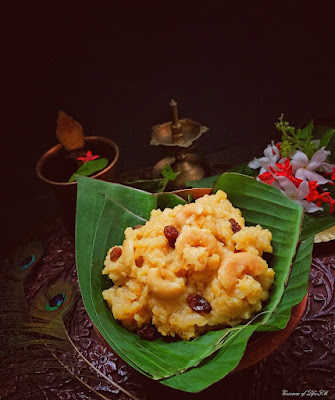 |
Traditional Cooking for Authentic Taste
The authentic flavour of Akkaravadisal comes from slow cooking in a bronze pot over a wooden fire in the temple kitchens (Madapalli). This method enhances the taste, making it a truly divine offering that carries centuries of tradition.
Akkaravadisal dish holds a special place, especially during Koodaravalli, an auspicious day observed on the 27th day of the Tamil month Margazhi, as part of the Pavai Nombu. Throughout Margazhi, Sri Andal sang daily verses of Thirupavai in praise of Lord Vishnu. To mark the end of Pavai Nombu, Akkaravadisal, the sweetest and most divine offering, is shared as a symbol of devotion and celebration.
As part of the Pongal celebrations, I’m excited to share my favourite recipe—Akkaravadisal. Click here for a detailed recipe...
Classic Sarkkarai Pongal for Festivities
Sarkkarai Pongal (or Chakkara Pongal) is a beloved sweet dish traditionally made during the Pongal Festival in South India. This comforting and rich recipe is prepared with raw rice, moong dal (Pasi Paruppu), jaggery, and a generous amount of ghee, garnished with cashews and raisins. It’s served as Naivedhyam/Prasadham in temples and during Poojas at home, making it a significant offering during religious occasions.
 |
Rice is the staple crop in South India, and alongside other local ingredients, Sarkkarai Pongal emerges as the quintessential dish for any celebration. The combination of raw rice and moong dal cooked together in milk, sweetened with jaggery, is the base of this delightful recipe. The dish is further flavoured with cardamom, dry ginger, edible camphor or cloves, and finished off with ghee-roasted cashews and raisins, giving it that unmistakable divine taste.
As we celebrate Pongal, it's time to share the delicious recipe for Sarkkarai Pongal, a Sweet Pongal Recipe that's perfect for any occasion. Click here for the full recipe and detailed instructions!
Kalkandu Pongal / Kalkandu Sadham: A Divine Temple Offering
Kalkandu Pongal (also known as Kalkandu Sadham) is a delightful, creamy dish made with raw rice, milk, and sweetened with rock sugar (Kalkandu). Flavoured with cardamom and garnished with roasted cashews and raisins in ghee, this dish is an essential part of temple offerings, especially in Madapalli (temple kitchens).
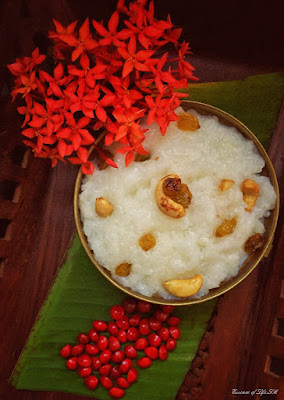 |
A Simple, Yet Sacred Dish
Kalkandu Pongal is a simple yet delicious recipe that can be made for any festival or pooja at home. It is traditionally offered as Naivedhyam (Prasadham) in temples, with the Chidambaram Natarajar Temple being one of the most famous places where this dish is served. The unique flavour and divine essence it carries, especially when prepared in the temple kitchens, makes this dish truly special.
Let’s delve into the creamy delight of Kalkandu Pongal/ Kalkandu Sadham, a traditional sweet made with rock sugar and milk. Perfect for festive occasions and temple offerings! Click here for the detailed recipe and instructions!
Aval Kalkandu Pongal: From Temple Kitchens to Your Home
Aval Kalkandu Pongal is a quick and creamy sweet dish made with Aval (flattened rice), milk, and rock sugar (kalkandu), flavoured with cardamom and garnished with roasted cashews and raisins. This authentic recipe is a cherished preparation from the temple kitchens (Madapalli), often served as prasadam during Margazhi, especially on auspicious occasions like Paavai Nombu.
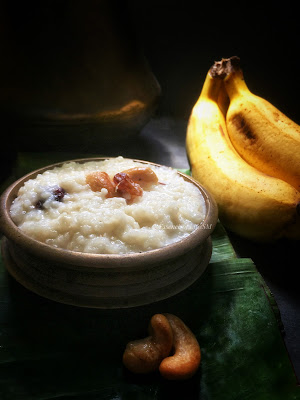 |
The unique charm of Aval Kalkandu Pongal lies in its simplicity and divine taste. Temples add a magical touch with a hint of edible camphor, giving it a distinct flavour that lingers on your palate. This sweet delight holds a special place in South Indian festivities, symbolising devotion and abundance.
Discover the rich and creamy flavours of Aval Kalkandu Pongal, a festive favourite and a cherished temple prasadham! Click here for the full recipe and step-by-step guide!
Millet Sweet Pongal: A Healthy Twist to Tradition
Festivals are a time for indulgence and delicious feasts, and Pongal is no exception! While the classic Sarkkarai Pongal is made with rice and dal, here's a healthier variation to try—Millet Sweet Pongal. This version replaces rice with millet, blending tradition with wholesome goodness.
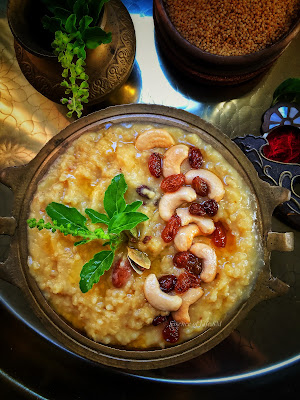 |
A Twist in Tradition
Though, festivals calls for indulgence and good food, as a norm I would like to prepare Pongal with Rice and Dhal. If you are looking for a twist and a healthier version, then this Millet Sarkkarai Pongal falls gently into the genre. The cooking method is same as how we make Sarkkarai Pongal with Rice, where millet is substituted instead of Rice. Millet and Moong Dhal(Pasi Paruppu) are used to prepare this Sweet Pongal and Jaggery(Cane Sugar) is used to sweeten the dish, which gives the name Sarkkarai Pongal/Chakkarai Pongal.
Millets, paired with moong dal (pasi paruppu), create a nutty and creamy base, while jaggery (cane sugar) adds its signature sweetness. The result? A divine dessert that’s perfect for festive celebrations, temple offerings, or even as a nutritious treat for your family.
Love Millets? Then don’t miss out on these Sweet Millet Pongal & Savoury Thinai Pongal, here!
Why Choose Millet Pongal?
- Healthier Alternative: Millets are packed with fibre, protein, and essential nutrients, making them a great substitute for rice.
- Festive Flavour: The method is identical to the classic Sarkkarai Pongal, ensuring you don’t miss out on the authentic taste.
- Versatile Dish: Ideal for festive naivedhyam, temple prasadham, or simply a wholesome dessert option.
Pro Tip: Choose Barnyard Millet/Kuthiraivali (குதிரைவாலி) or Foxtail MilletThinai (தினை) for a soft and creamy consistency. Roast the millet lightly for added flavour before cooking.
Moonu Raja Pongal: A Unique Tradition Honouring Epiphany
The tradition of making Moonu Raja Pongal or Three Kings Pongal for Epiphany, observed in the Karaikkal and Pondicherry regions—a French colonial town—is a fascinating blend of culture and history. This age-old custom, rooted in January's festive spirit, was entirely new to me. It amazed me to discover a dish so deeply traditional and uniquely South Indian, created to commemorate this special day.
 |
| Moonu Raja Pongal - A South Indian Epiphany Pongal |
Crafted with simple, locally available ingredients like raw rice, coconut milk, and sugar, Moonu Raja Pongal embodies the essence of Tamil Nadu’s culinary heritage. Interestingly, Epiphany coincides with Tamil Nadu’s Harvest Festival, Pongal, making this dish even more significant.
What adds more intrigue is the historical narrative behind this tradition. Some believe that this Pongal is prepared to honour the Three Great Kings who ruled Tamil Nadu and parts of Kerala—the Cheras, the Cholas, and the Pandyas—revered as the "Moovendars" (Three Kings). This dish not only celebrates a Christian festival but also pays homage to Tamil Nadu’s royal lineage.
Moonu Raja Pongal Recipe is an exceptional blend of tradition, history, and flavours—a perfect addition to your Pongal or Epiphany celebrations!
Aravana Payasam: The Divine Prasadam of Sabarimala
Aravana Payasam, a delectable prasadham from the sacred Sabarimala Shree Ayyappa Swami Temple, holds a revered place in South Indian culture. As the most important offering made at Sabarimala, this divine dish represents devotion and simplicity at its finest.
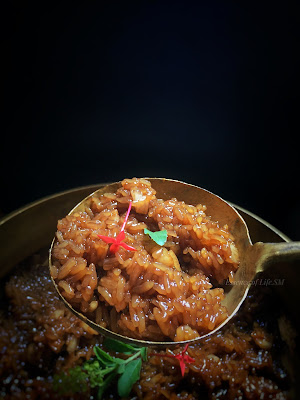 |
| Divine Aravana Payasam - Sabarimala Prasadham |
Made with just three ingredients—Unakkalari (raw rice), Sarkkara (jaggery), and ghee—Aravana Payasam is a perfect blend of rich flavours and spiritual essence. Despite its simplicity, this payasam leaves an unparalleled impression on both taste buds and hearts. Perhaps that's the magic of prasadhams—they nourish not just the body but also the soul.
Growing up, I’ve always admired how my parents made the best Neypayasam and Aravana Payasam, especially for Annadhanam (community feasts). The kitchen would fill with the mesmerising aroma of jaggery caramelising in ghee, a fragrance that remains etched in my memory. Whether you're recreating this recipe for a special occasion or as a personal offering, its divine flavour will surely leave you in awe!
Experience the Emotion of Aravana Payasam: Recreate this divine prasadham at home and connect with its cherished tradition and spirituality. Click here for the recipe!
Neypayasam: Kerala’s Temple Prasadham
Neypayasam is a divine dessert served as prasadham in most Kerala temples. Made by slow-cooking Raw Rice/Unakkalari with generous amounts of Ghee and Jaggery, this sweet indulgence is thick, rich, and meant to be savoured in small portions.
While Neypayasam and Aravana Payasam aren’t traditionally termed as Pongal, their ingredients and significance as temple prasadhams make them a perfect fit for the Sweet Pongal genre. If you're craving a Kerala-style Pongal without dhal, these Payasams are a delicious and unique choice.
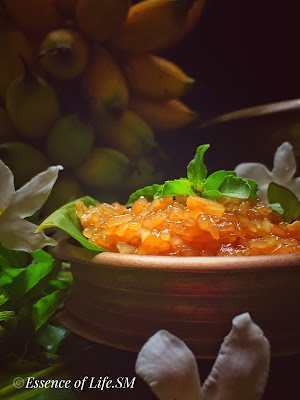 |
Why Neypayasam Stands Out
- Temple Tradition: Neypayasam is a symbolic offering of devotion and gratitude in Kerala Temples.
- Rich and Decadent: With its deep caramel notes from jaggery and the aroma of pure ghee, it’s a feast for the senses.
- Versatile Treat: Ubiquitous offereings in most Kerala Temples & it fits beautifully into festive spreads, Pirannal(Birthday) Sadhyas , or special family meals.
Savour the authentic taste of Kerala temples with Neypayasam, a divine treat steeped in ghee and jaggery. Click here for the full recipe and tip
Chak Hao Amubi – Manipuri Black Rice Kheer: A Unique Dessert with a Nutty Twist
Chak Hao Amubi, a delightful treat from the enchanting Northeastern region of India, showcases the rich culinary traditions of Manipur. This kheer, made with the distinctive black glutinous rice, is reminiscent of the Chettinad specialty, Kavuni Arisi Pongal (which has its roots from Myanmar - the earlier Burma), yet carries its own unique flavour profile.
Black rice, known as Amubi in Manipuri—takes centre stage in this dessert. And thus the dessert Chakhao Amubi,—where Chakhao means delicious and Amubi means black gets its name. The rice's nutty aroma and flavour develop beautifully as it is slow-cooked with minimal ingredients, making this kheer a simple yet decadent delight.
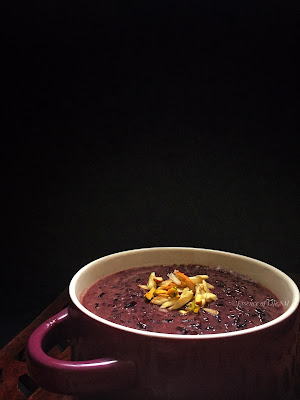 |
Traditionally served during major feasts, festive events, and special occasions, Chak Hao Amubi embodies the spirit of Manipur’s culinary artistry. Its dark, alluring hue, combined with a mildly sweet taste, makes it an ideal choice for celebratory meals. And the best part? This kheer is as nutritious as it is delicious, thanks to the nutrient-packed black rice.
If you're looking for a unique dessert that’s not only easy to prepare but also impressively exotic, Chak Hao Amubi is the perfect pick. Click here for a detailed recipe, a dessert that’s both visually striking and flavour.
Savoury Pongals - Ven Pongals
Ven Pongal, also known as Khara Pongal, is the savoury counterpart to the sweet Pongal. This classic South Indian tiffin item holds a special place in traditional breakfasts and festive spreads. Popularly served in restaurants and during functions or weddings, Ven Pongal is cherished for its simplicity, rich flavours, and wholesome nutrition.
Why You’ll Love Ven Pongal
- Simple Ingredients: Made with pantry staples, Ven Pongal doesn’t require elaborate preparations.
- Quick and Easy: With minimal cooking time, it’s a great option for busy mornings.
- Customisable: From adding roasted cashews to drizzling extra ghee, this dish is versatile.
- Comfort Food: Its creamy, soft texture is the ultimate comfort for any time of the day.
A Festive Favourite
Ven Pongal isn’t limited to breakfast tables. It’s a star dish during Pongal celebrations in Tamil Nadu and is also popular in the southern parts of Andhra Pradesh. Its rich and comforting taste makes it a go-to option for festive mornings. Additionally, variations like Ven Pongal with raw rice, millets, or even semolina provide exciting options for those looking to explore different flavours and textures.
Ven Pongal/Khara Pongal: A Quintessential South Indian Delight
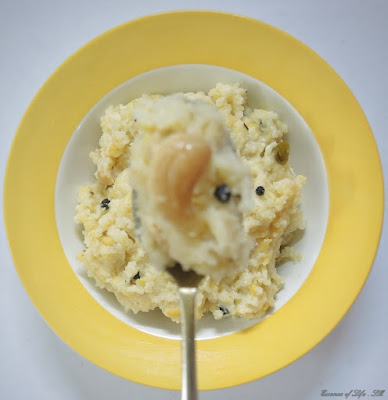 |
A Unique Culinary Treat
While the base ingredients mirror those of Sweet Pongal, the savoury twist in Ven Pongal comes from its delightful seasoning. Mild spices like black pepper and cumin seeds are tempered in generous amounts of ghee, lending a distinctive aroma and flavour. This minimal yet effective seasoning elevates the dish, making it a comforting meal that satisfies both the palate and the soul.
Wholesome and Nutritious
Ven Pongal is more than just a flavourful dish—it’s a perfect blend of carbohydrates and proteins. The split moong dal (yellow lentils) and rice combine to create a balanced meal. Additionally, the inclusion of spices like black pepper and cumin adds to its health benefits, making it a nourishing choice to kickstart the day.
If you're looking for a Savoury Pongal Varieties that’s not only easy to prepare but also complete meal, Ven Pongl prepard with Raw Rice & Moong dhal, is the perfect pick. Click here for a detailed recipe, a dish that’s both wholesome and flavourful.
Rava Pongal/Semolina Pongal: A Delightful Twist on Tradition
Rava Pongal, also known as Semolina Pongal, is a creative take on the classic Ven Pongal recipe. In this version, the traditional rice base is replaced with white rava (semolina), resulting in a dish that’s soft, light, and incredibly satisfying. Loved for its unique texture and simplicity, Rava Pongal is a must-try variation for anyone seeking a wholesome and delicious meal.
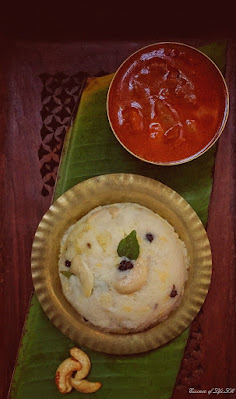 |
Why Rava Pongal Stands Out
- Soft and Light Texture: Semolina lends a delicate and fluffy consistency, making it lighter than rice-based Pongal.
- Quick and Easy: Perfect for busy mornings or when you’re short on time.
- Nutritious and Versatile: Packed with the goodness of semolina and moong dal, it’s a balanced dish that can be customised with your favourite toppings like roasted cashews or extra ghee.
A Modern Take on a Classic
Rava Pongal retains the essence of Ven Pongal while offering a modern twist. The combination of semolina with the aromatic seasoning of black pepper, cumin seeds, and ghee creates a comforting dish that’s both nutritious and flavourful. It’s a wonderful option for breakfast, brunch, or even a light dinner.
Love Savoury Pongal Varieties? Rava Pongal, crafted with the goodness of Semolina and Moong Dal, is a light, fluffy twist on tradition that you simply can’t miss! Discover the Detailed Recipe Here!
Thinai Pongal – A Healthier Twist on Traditional Pongal
Thinai Pongal/Foxtail Millet Pongal, is a delightful variation of the classic South Indian dish, Ven Pongal. By swapping rice for the nutritious and fibre-rich Foxtail Millet (Thinai), this dish offers a healthier, yet equally comforting alternative. The best part? The method remains nearly the same, with a slight tweak in the millet-to-water ratio.
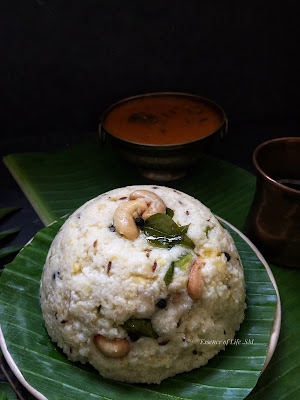 |
Why Try Millet Pongal?
- Melt-in-the-mouth texture: Millet Pongal has a softer, more delicate texture compared to traditional rice Pongal, making it irresistibly delicious.
- Nutrient-packed: Millets, such as Foxtail Millet, Kodo Millet (Varagu Arisi), Little Millet (Samai), and Barnyard Millet (Kuthiraivali), are high in fibre and other essential nutrients.
- A healthier choice: Incorporating millets into your meals boosts digestion, stabilises blood sugar, and promotes overall well-being.
Whether you're making Millet Pongal for breakfast, lunch, or dinner, it’s an easy, filling meal that fits into any part of your day.
A Simple, Yet Satisfying Recipe
For this recipe, I’ve used the classic pressure cooker method to make it quick and hassle-free. The ratio of Thinai (Foxtail Millet) to water is 1:3, and I’ve substituted half a cup of water with milk to make the Pongal extra creamy and soft. A generous dollop of ghee adds that final touch of richness!
This ratio works equally well for other millets like Samai (Little Millet) and Kuthiraivali (Barnyard Millet). It’s versatility at its best!
Craving a healthier twist on the traditional Ven Pongal? Don’t miss out on my Millet Pongal – Thinai Venpongal Recipe – a perfect, fibre-rich alternative that’s both delicious and nutritious. Click to discover how this comforting dish can elevate your meals!
Complete Your Pongal Feast with Perfect Side Dishes
Pairing Sweet Pongal and Ven Pongal with the right side dishes elevates the festive experience. Here's how you can make your Pongal menu even more delightful.
Perfect Side Dishes for Ven Pongal/Khara Pongal
Ven Pongal or Khara Pongal pairs beautifully with a variety of flavourful side dishes that elevate the comforting dish into a feast. While the classic Coconut Chutney and aromatic Sambar are timeless favourites, there’s so much more you can explore to create a vibrant Pongal spread.
Classic Pairings
- Sambar: A bowl of warm, spiced lentil stew is the perfect complement to Pongal's creamy texture. Add locally available vegetables like brinjal/eggplant, pumpkin, squash, okra, drumstick or radish for an earthy depth of flavour.
- Chutneys: Fresh coconut chutney is a must-try, but you can also experiment with mint-coriander chutney or spicy tomato chutney for a twist.
Delicious Add-ons
Mochai Kottai Puli Kuzhambu
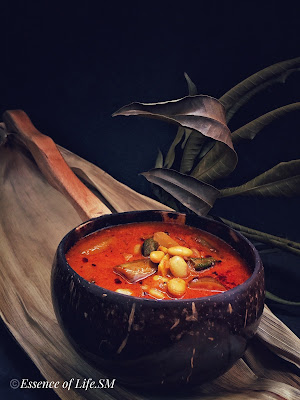 |
I love to prepare a Spicy and Tangy Curry to pair with Pongal, featuring a medley of vegetables and Mochai Kottai (Lima Beans). This simple yet flavour-packed dish is none other than the beloved Puli Kuzhambu, a tamarind-based curry that perfectly complements the mild, creamy texture of Pongal.
Another classic variation often served during the Pongal festival is the Pongal Puli Kuzhambu. This traditional dish stands out for its unique combination of locally sourced vegetables such as sweet potato, raw plantain, squash, eggplant, taro, and broad beans, paired with lima beans for added texture and protein. The rich, tangy flavours of tamarind and the warm spices make it a quintessential addition to the Pongal menu.
Whether you’re serving it with Ven Pongal or Khara Pongal, this flavourful Puli Kuzhambu elevates the meal, bringing balance and depth to your festive spread. Click the link for a detailed recipe.
Uzhundhu Vadai - The Perfect Accompaniment for Your Pongal Menu
A Pongal feast feels incomplete without the addition of golden, crispy Uzhundhu Vadai, famously known as Medhu Vadai. These lentil fritters, with their crisp exterior and fluffy interior, bring an irresistible crunch to the festive spread. Uzhundhu Vadai pairs delightfully with coconut chutney and steaming hot sambar, offering a balance of textures and flavours.
Complete your Pongal Menu with crispy Uzhundhu Vadai, perfectly paired with Sweet Pongal and Ven Pongal. Click here for recipe best!
Celebrate Pongal with a Hearty Feast!
Festival time is all about celebrating togetherness, traditions, and, of course, indulging in good food. This Pongal, let your festive table shine with a delightful spread of both Sweet Pongal and Ven Pongal, paired with traditional side dishes that make every bite memorable.
Complete your Pongal menu with crispy Uzhundhu Vadai, flavour-packed Sundal, and comforting sides like Sambar, Coconut Chutney, or tangy Puli Kuzhambu. End the celebration on a warm note with a steaming cup of Filter Coffee or aromatic Masala Tea.
Pro Tip: Serve everything on a banana leaf to embrace traditional vibes and make the meal more special!
 |
What’s on the Pongal Menu?
To craft a festive Pongal feast, include these essential dishes:
- Sweet Pongal or Rava Kesari for a sweet start.
- Ven Pongal, a savoury delight.
- Side dishes like Sambar, Chutney, or Puli Kuzhambu for balance.
- Uzhundhu Vadai for a crispy, indulgent treat.
- A choice of Sundal for added texture and flavour.
- Complete the feast with a hot cup of Filter Coffee or Masala Tea.
To make your festival truly special, Check out the complete Pongal Menu here for detailed recipes and pro tips
Let’s Celebrate Pongal together!
This Pongal, share the joy of good food with loved ones and savour every bite. Whether you’re hosting a big gathering or keeping it simple, this menu is sure to win hearts.
Celebrate with this delicious Pongal Menu, and don't forget to share your creations!
Happy Pongal - PONGALO' PONGAL!!!











0 comments